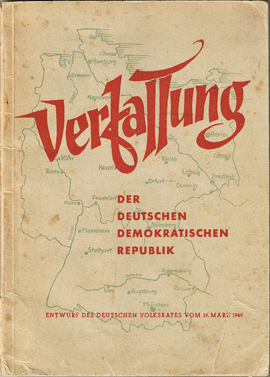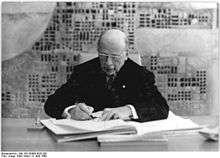Constitution of East Germany

The German Democratic Republic (East Germany) was founded in 1949 and was absorbed into the Federal Republic of Germany on 3 October 1990. Its original constitution was promulgated on 7 October 1949. It was heavily based on the "Weimarer Reichsverfassung", (Weimar Constitution)[1] such that the GDR would be a federal and democratic republic. Because the original version did not accurately reflect the actual political climate of the GDR, it was decided in 1968 to replace the old constitution with a new version.
1949 constitution
The first constitution of the GDR was proclaimed on 7 October 1949, based largely on a draft prepared by the Socialist Unity Party (SED) in September 1946. The 1949 constitution was intended for a united Germany and may have been written before the Soviet Union had irrevocably decided to establish a separate socialist republic in its zone of occupation. The constitution both resembled and differed from Western parliamentary democracies in various respects. With regard to state organization, the 1949 constitution resembled, at least superficially, the Basic Law (Grundgesetz) of the Federal Republic of Germany (West Germany). As in other parliamentary-democratic systems, provision was also made for two legislative assemblies, the States Chamber (Länderkammer) and the People's Chamber (Volkskammer), and the election of a prime minister (Ministerpräsident) by the party with the largest mandate in the People's Chamber. The president of the GDR, like his Western counterpart, had a very limited role and was removable by a joint two-thirds majority vote in both houses.
Lawmaking was essentially the job of the Volkskammer rather than the Länderkammer, but the latter could propose draft laws to the former. The legislative process also exhibited important differences from the West German model; the East German upper house, the Länderkammer, for example, which represented the interests of the individual states, occupied a much weaker position than its West German counterpart. The Volkskammer was constitutionally defined as the highest organ of state power. Article 51 stated that the members of the Volkskammer were to be elected in universal, equal, and secret elections based on the relative majority principle. Another important difference concerned the role of political parties in the government. According to Article 92, parties with at least 40 seats in the Volkskammer, which then had a total of 400 members, had the right to representation in the government. This policy was consistent with the SED's Marxist Alliance Policy, which stipulated that in order to achieve its aims, the party of the working class must initially work with and through other parties. It also ensured that if the SED was ever demoted to a minority position, its continued influence in the government would be safeguarded if it maintained a minimum of 40 seats. A set of basic human rights, including the right to strike (Article 14) and to emigrate (Article 10) retained features of a liberal Rechtsstaat and formally guaranteed that sovereignty would remain vested in the people.
The 1949 constitution was a compromise; it could have served either as a basis for building a socialist (and eventually Communist) society or as the basis for a democratic all-German republic. Critics have pointed out that the absence of a genuinely independent constitutional judiciary (since it and all other governmental organs were subordinated to the Volkshammer) rendered the document virtually meaningless, however. As time progressed, the authorities ignored most of its formal provisions and permitted the emergence of a centralized political order similar to that of other Communist countries, in which the state bodies did little more than rubber-stamp decisions already made by the SED and its Politburo.
Several important amendments were made at the initiative of the SED in the eighteen years in which the constitution was in force. An amendment of August 1950 eliminated state parliaments and called for the election of parliamentary deputies through the creation of a joint platform and lists organized by the National Front, the SED-dominated umbrella organization of all political parties and mass organizations. A 1952 decision replaced the five states (Länder) with fifteen administrative districts (Bezirke) that were tied more directly to the central government. (The United States, Britain, and France never recognized East Berlin as a Bezirk of the GDR.) This step effectively neutered the Länderkammer, and formed the basis for its formal dissolution by constitutional amendment in December 1958. A series of amendments known as the Law Toward the Completion of the Constitution were passed by the People's Chamber in March 1954, when the country was formally granted sovereignty by the Soviet Union. These amendments delineated the features of the country's new sovereignty and a formal military structure, which prepared the ground for the obligatory military service clause of 1955. Finally, upon the death of President Wilhelm Pieck on 7 September 1960, a constitutional amendment of 12 September 1960 replaced the office of President with the Council of State (Staatsrat der DDR); Walter Ulbricht became its first chairman. The same constitutional amendment also acknowledged the role of the recently formed National Defense Council of the GDR (Nationale Verteidigungsrat der DDR) in GDR defense policy.
1968 constitution

At the Seventh Party Congress of the SED in April 1967, Ulbricht called for a new constitution, declaring that the existing constitution no longer accorded "with the relations of socialist society and the present level of historical development". A new constitution was needed to conform with the Marxist–Leninist belief in the progression of history and the role of the working class led by the SED. The new constitution would also reflect the role of the state as the party's main instrument in achieving the goal of a socialist and eventually communist society. A commission in the Volkskammer was tasked in December 1967 to draft a new constitution. Two months later the commission produced a document, which, after "public debate", was submitted to a plebiscite on April 6, 1968. Approved by a 94.5 percent margin, the new Constitution went into effect three days later on 9 April 1968.
While the 1949 constitution was at least superficially a liberal democratic document, the 1968 constitution was a fully Communist document. Modeled closely on the 1936 Soviet Constitution, it integrated all the constitutional changes that had taken place since 1949 into a new "socialist" framework, but it reduced certain rights provided in the earlier version. Article 1 of the 1968 constitution began with the words, "The German Democratic Republic is a socialist state of the German nation. It is the political organization of the workers in the cities and in the countryside, who jointly under the leadership of the working class and their Marxist-Leninist party will realize Socialism."
While the old document made no mention of the SED, Article 1 of the new constitution unequivocally declared that "the leadership of the state is to be exercised through the working class and its Marxist-Leninist party"—the SED. The 1949 constitution had declared Germany a "democratic republic", whereas the new one described East Germany as a "socialist state of the German nation". Under the old constitution, power derived from "the people", while Article 2 of the new Constitution stated that power emanated from "the worker in city and country".
Significant changes introduced into the 1968 document included:
- Article 6, which committed the state to adhere to the "principles of socialist internationalism" and to devote special attention to its "fraternal ties" with the Soviet Union
- Article 9, which based the national economy on the "socialist ownership of the means of production"
- Article 20, which granted freedom of conscience and belief; while added under pressure from the churches, this right was not respected in practice
- Article 21, which maintained that the "basic rights" of citizenship were inseparably linked with "corresponding obligations"
- Article 47, which declared that the principle of "democratic centralism" is the authoritative maxim for the construction of the socialist state
1974 amendments

With the rise of Erich Honecker in May 1971 and the increasing international recognition of the GDR, the regime attempted to abandon the concept that the GDR was the sole legitimate government of the entire German nation. Instead, the policy of Abgrenzung (demarcation) was instituted, with the desired effect of creating a separate GDR national identity. As a result, the 1968 constitution was amended by the Volkskammer on 27 September 1974 to delete the reference to the German nation and to further increase the emphasis on solidarity and friendship with the Soviet Union. In practice, however, ties between East Germans and their West German countrymen increased, in part due to the policies of Ostpolitik and détente followed by both East and West during the 1970s.
Article 1 of the 1974 constitution began with the words, "The German Democratic Republic is a socialist state of workers and farmers. It is the political organization of the workers in the cities and in the countryside under the leadership of the working class and their Marxist-Leninist party."
1989–90 proposals
The constitution was significantly revised in November 1989, in the wake of the Peaceful Revolution and the fall of the Berlin Wall. Most notably, Article 1, which effectively gave the SED a monopoly of power, was deleted.
In April 1990, the democratic forum Runder Tisch (Round Table) developed a proposal for a new GDR constitution to reflect the democratic changes that swept across the GDR. However, by that time, the newly freely-elected Volkskammer (parliament) was moving in the direction of outright unification with the Federal Republic, and so the draft constitution went nowhere.
| Wikisource has original text related to this article: |
See also
Constitutions of Germany
- Constitution of the German Empire (1871–1919)
- Weimar Constitution (1919–1933)
- Basic Law for the Federal Republic of Germany (Federal Republic of Germany, 1949–)
Others
References
External links
- 1949 Constitution of the GDR (full text in German)
- 1968 Constitution of the GDR (full text in German)
- Excerpts from the 1968 Constitution (in English)
- 1974 Constitution of the GDR (full text in German)
- 1990 Proposed draft of a new GDR constitution (full text in German)
- East Germany – Constitution of 1949
![]() This article incorporates public domain material from the Library of Congress Country Studies document "East Germany".
This article incorporates public domain material from the Library of Congress Country Studies document "East Germany".